White Gold: How Salt Made and Unmade the Turks and Caicos Islands
Turks and Caicos had one of the world’s first, and largest, salt industries
![]()
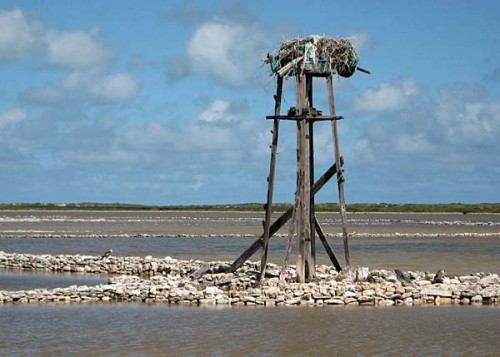
The remains of a windmill, once used to pump brine into the salt pans of the Turks and Caicos Islands. Photo credit: www.amphibioustravel.com.
Salt is so commonplace today, so cheap and readily available, that it is hard to remember how hard to come by it once was. The Roman forces who arrived in Britain in the first century C.E reported that the only way the local tribes could obtain it was to pour brine onto red-hot charcoal, then scrape off the crystals that formed on the wood as the water hissed and evaporated. These were the same forces that, according to a tradition dating to the time of Pliny the Elder, gave us the word “salary” because they once received their wages in the stuff.
Salt was crucially important until very recently not merely as a condiment (though of course it is a vital foodstuff; hearts cannot beat and nerve impulses cannot fire without it), but also as a preservative. Before the invention of refrigeration, only the seemingly magical properties of salt could prevent slaughtered animals and fish hauled from the sea from rotting into stinking inedibility. It was especially important to the shipping industry, which fed its sailors on salt pork, salt beef and salt fish. The best salt meat was packed in barrels of the granules–though it could also be boiled in seawater, resulting in a far inferior product that, thanks to the scarcity of fresh water aboard wooden sailing ships, was then often cooked in brine as well, reaching the sailors as a broth so hideously salty that crystals formed on the sides of their bowls. The demand for salt to preserve fish was so vast that the Newfoundland cod fishery alone needed 25,000 tons of the stuff a year.
All this demand created places that specialized in producing what was known colloquially as “white gold.” The illustration above shows one remnant of the trade in the Turks and Caicos Islands, a sleepy Caribbean backwater that, from 1678 to 1964, subsisted almost entirely on the profits of the salt trade, and was very nearly destroyed by its collapse. The islands’ history is one of ingenuity in harsh circumstances and of the dangers of over-dependence on a single trade. It also provides an object lesson in economic reality, for the natural products of the earth and sky rarely make those who actually tap them rich.
The islands, long a neglected part of the British empire, lie in the northern reaches of the Caribbean, far from the major trade routes; their chief call on the world’s notice, before salt extraction began, was a disputed claim to be the spot where Christopher Columbus made landfall on his first voyage across the Atlantic. Whether Columbus’s first glimpse of the New World really was the island of Grand Turk (as the local islanders, but few others, insist), there is no doubt about the impact the Spaniards had once they began to exploit their new tropical empire. The indigenous population of the Turks and Caicos—estimated to have numbered several tens of thousands of peaceable Lucayan Amerindians—made a readily exploitable source of slave labor for the sugar plantations and gold mines the conquistadores established on Haiti. Within two decades of its discovery, the slave trade and the importation of diseases to which the Lucayans possessed practically no resistance (a large part of the European portion of what is termed the Columbian Exchange), had reduced that once-flourishing community to a single elderly man.
By the 1670s, not quite two centuries after Columbus’s first voyage, the Turks and Caicos were uninhabited. This was very much to the advantage of the next wave of settlers, Bermudans who arrived in the archipelago in the hope of harvesting its salt. Though by global standards the Atlantic island is a paradise of lush vegetation and balmy airs—so much so that it was hymned by Shakespeare—Bermuda was too cool and too damp to produce white gold. But it had a population of hardy seafarers (most of them originally Westcountrymen, from the further reaches of the British Isles) and plenty of good cedar to make ships.
Venturesome Bermudans lighted on the Turks and Caicos as an ideal spot to begin producing salt. In addition to being uninhabited—which made the islands “commons,” in the parlance of the time, open to tax-free exploitation by anyone—the islands had extensive coastal flatlands, which flooded naturally at high tide and baked under the tropical sun. These conditions combined to produce natural salt pans, in which—the archaeologist Shaun Sullivan established by experiment in 1977—16 men, armed with local conch shells to use as scoopers, could gather 140 bushels of salt (about 7,840 pounds) in a mere six hours.
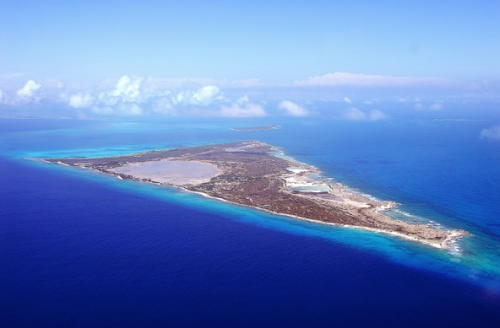
Salt Cay, home to the Turks and Caicos Islands’ sole export industry. The island consists of a two-mile-long expanse of natural salt pans.
The best place in the Turks and Caicos to make salt was a low triangular island to the south of Grand Turk known today as Salt Cay. Measuring no more than two miles by two and a half, and tapering to a point at its southern end, this island was so low-lying that much of it was underwater twice a day. The Bermudans worked these natural salt pans and added some refinements of their own, building stone cofferdams to keep out the advancing tides and rickety windmills to power pumps. Thus equipped, they could flood their pans at will, then wait for the brine to evaporate. At that point, the job become one of adding muscle power. Salt was raked into the vast mounds that for decades dominated the island scenery, then loaded onto ships headed north. By 1772, in the last years before the American War of Independence, Britain’s North American colonies were importing 660,000 bushels annually from the West Indies: nearly 40 million pounds of white gold.
At this stage, the Turks and Caicos were practically undefended and prone to attack by passing vessels; the French seized the territory four times, in 1706, 1753, 1778 and 1783. In those unfortunate circumstances, white workers captured on common land would eventually be released, while enslaved blacks would be seized and taken off as property. As a result, the early laborers in the Turks and Caicos salt pans were mostly sailors. Bermuda’s governor John Hope observed what was for the times a highly unusual division of labor:
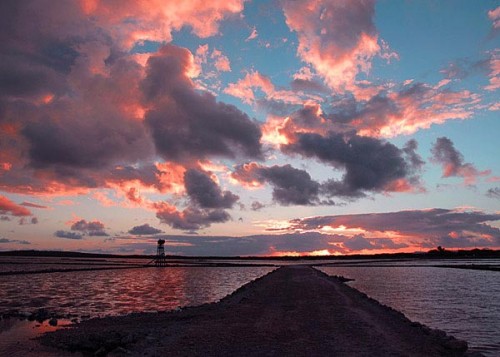
Sunrise over the Turks and Caicos salt pans. Photo credit: www.amphibioustravel.com
All vessels clear out with a number of mariners sufficient to navigate the vessel anywhere, but they generally take three or four slaves besides gathering of salt at Turks Island, etc. When they arrive, the white men are turn’d ashore to rake salt… for ten or twelves months at a stretch the master with his vessel navigated by Negroes during that time goes a Marooning–fishing for turtles, diving upon wrecks, and sometimes trading with pyrates. If the vessels happen to be lucky upon any of these accounts, Curacao, St Eustatia, or the French islands are the ports where they are always well received without questions asked… If not, they return and take in their white sailors from the Turks Islands, and… proceed to some of the Northern Plantations .
From a purely economic perspective, the system paid dividends for the ship’s owners; the white sailors were—relatively—happy to have a steady living, rather than depending on the uncertainties of the Caribbean’s inter-island trade, while the captains saved money by paying their black sailors low wages. The system changed only in the 1770s, when a cold war erupted between Bermuda and a second British crown colony, the Bahamas, with the result that the islands ceased to be a commons and became a hotly contested British dependency.
The 1770s saw two important changes in the Turks salt trade. First, the victory of the American colonists in their War of Independence led to the flight of loyalist settlers, who took their slaves with them and—in a few cases, at least—settled on the Turks and Caicos. The introduction of slavery into the archipelago provided a new source of cheap labor to the now better-defended salt trade. The second change was ignited by a decision made in the legislature of the Bahamas to seek jurisdiction over the Turks and Caicos, which thus ceased to be common land and became a crown colony. The Bahamian acts imposed two crucial new conditions on the Turks salt rakers: They had to reside on the islands permanently, rather than for the 10 months at a time that had been the Bermudan custom; and any slaves who missed more than 48 hours of work during the 10-month season would forfeit their owner’s share in the profits. The aim, quite plainly, was to disrupt Bermudan salt raking and take control of what was an increasingly lucrative trade.
The Bermudans, as might be expected, did not take all this very kindly. Their Assembly pointed out that 750 of the new colony’s 800 rakers were Bermudan and argued that the Turks and Caicos lay outside the Bahamas’ jurisdiction. Meanwhile, on the islands, a group of salt rakers took matters into their own hands and beat up a Bahamian tax man who had been sent there to collect a poll tax and new salt duties imposed by the Nassau government. In 1774, Bermuda sent a heavily armed sloop-of-war to the Turks and Caicos to defend its waters not against enemy Frenchmen or Spaniards, but their supposed allies, the Bahamians. Only the distraction of the American war prevented the outbreak of full-blown hostilities between the two colonies over the Turks salt trade.
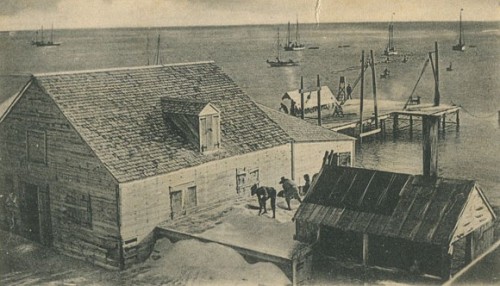
The salt grinding house on Grand Turk processed the islands’ annual crop of white gold. Nineteenth-century century postcard.
Hatred of the Bahamas ran high in the Turks and Caicos then, and it continued to play an important role in what passed for island politics for a further century. A British government resolution of 1803, aimed at ending the possibility of bloodshed, formally transferred the islands to the Bahamas, and in the first half of the 19th century salt taxes made up fully a quarter of the Nassau government’s revenues—a fact bitterly resented on Grand Turk, whose representative in the Bahamian House of Representatives, the writer Donald McCartney says, “did not attend meetings regularly because he was not made to feel part of the Bahamian legislature.” It was commonly observed in the Turks and Caicos that little of the tax was used to improve the islands.
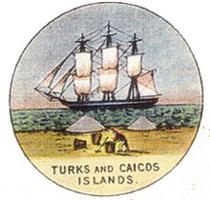
The badge of the Turks and Caicos, which adorned its flag until it became a stand-alone crown colony in the 1970s, was inspired by the local salt trade. Between the 1880s and 1966, thanks to a foul-up in London, the right hand of the two piles of salt was given a smudgy black “door”—the result of a civil servant’s ignorant assumption that the islands lay somewhere in the Arctic, and the objects were igloos.
London seemed barely to care about things that mattered greatly on Grand Turk. When in the 1870s the British government decided that the Turks and Caicos needed its own flag, an artist was commissioned to paint some characteristic local scenes; his view lighted on two vast piles of white gold sitting on a quayside, awaiting loading into a freighter. The resultant sketch was sent to London to be worked into a badge that sat proudly in the center of the islands’ flag, but not without the intervention of a puzzled official in the Admiralty. Arctic exploration was then much in vogue, and—apparently having no idea where the Turks and Caicos were, and presuming that the conical structures in the sketch were poor representations of ice—the unknown official helpfully inked in a door on the right side of the salt piles, the better to indicate that they were actually igloos. It says much for British ignorance (and the islanders’ politeness) that this error was not corrected until the 1960s, when the smudge was removed in honor of Queen Elizabeth’s state visit to Grand Turk.
The friction between the islands and their Bahamian neighbors explains one further peculiarity in Turks and Caicos history: the geographically absurd link between the islands and distant Jamaica, which began in 1848, when the British government at last agreed to the islanders’ repeated pleas to be freed from Bahamian exploitation. From that year until Jamaica’s independence in 1962, the Turks and Caicos was ruled from Kingston, and a brief reunion with the Bahamas between 1962 and 1974 showed that not much had changed; renewed dissatisfaction in the Turks and Caicos meant that the islands became a separate crown colony from the latter date.
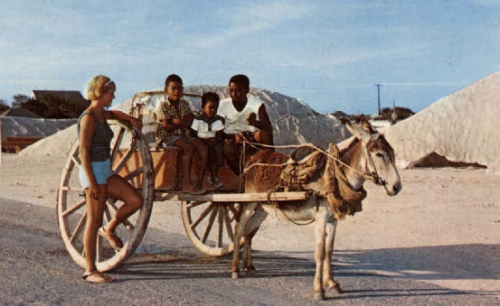
The last days of the Turks salt industry, in the early 1960s. Contemporary postcard.
Those who have read this far will not be surprised to hear that the cause of the fighting was still salt. Cut off from the revenues of the Turks salt trade after 1848, the Bahamians went on to build a salt trade of their own, building new salt pans in Great Inagua, the most southerly island in the Bahamas group. By the 1930s, this facility was producing 50,000 tons of salt a year and providing stiff competition to the Turks salt trade; by the 1950s, the introduction of mechanization in Great Inagua had rendered the salt pans of Salt Cay economically redundant.
The tragedy of the Turks and Caicos islands was that they had no way to replace their devastated salt trade; mass tourism was, in the 1960s, still more than two decades off, and for the next 20 years the islanders subsisted on little more than fishing and, for a criminal few, the drug trade. The islands sit 600 miles north of Columbia and 575 miles southeast of Miami, and made for a useful refueling spot for light aircraft carrying cocaine to the American market—one with the added benefit, as Harry Ritchie puts it, of “a law-abiding populace who wouldn’t dream of carrying out a heist on any Class A cargo, but some of whom could be persuaded, for a tidy sum, to light the odd fire on deserted airstrips at certain times of the night.”
Sources
Michael Craton and Gail Saunders. Islanders in the Stream: A History of the Bahamian People. Athens , 2 volumes: University of Georgia Press, 1999; Michael J. Jarvis. In the Eye of All Trade: Bermuda, Bermudians, and the Maritime Atlantic World, 1680-1783. Chapel Hill: University of North Carolina Press, 2010; Mark Kurlansky. Salt: A World History. London: Cape, 2002; Pierre Laszlo. Salt: Grain of Life. New York: Columbia University Press, 2001; Donald McCartney. Bahamian Culture and Factors Which Impact Upon It. Pittsburgh: Dorrance Publishing, 2004; Jerry Mashaw and Anne MacClintock. Seasoned by Salt: A Journey in Search of the Caribbean. Dobbs Ferry : Sheridan House, 2003; Sandra Riley and Thelma Peters. Homeward Bound: A History of the Bahama Islands to 1850. Miami: Riley Hall, 2000; Harry Ritchie. The Last Pink Bits: Travels Through the Remnants of the British Empire. London: Sceptre, 1997; Nicholas Saunders. The Peoples of the Caribbean: An Encyclopedia of Archaeology and Traditional Culture. Santa Barbara : ABC Clio, 2005; Sue Shepherd. Pickled, Potted and Canned: The Story of Food Preserving. Darby : Diane Publishing, 2003; Shaun Sullivan. Prehistoric Patterns of Exploitation and Colonization in the Turks and Caicos Islands. Unpublished PhD dissertation, University of Illinois, 1981.
/https://tf-cmsv2-smithsonianmag-media.s3.amazonaws.com/accounts/headshot/mike-dash-240.jpg)
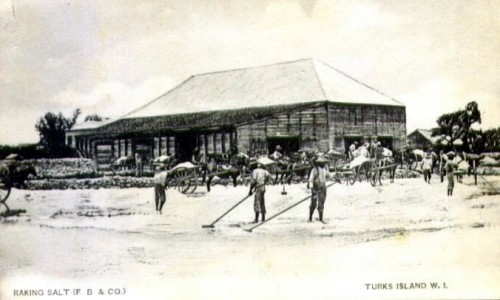
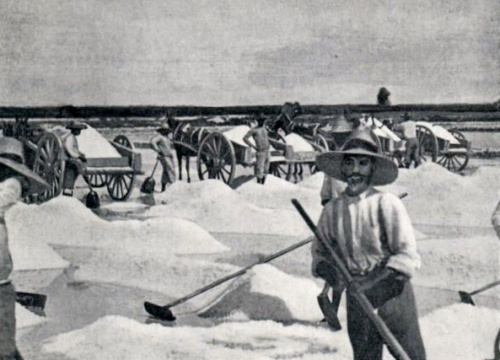
/https://tf-cmsv2-smithsonianmag-media.s3.amazonaws.com/accounts/headshot/mike-dash-240.jpg)